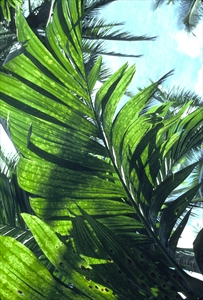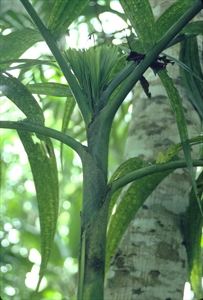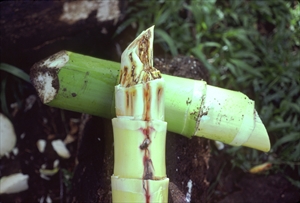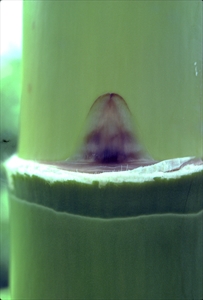Betel nut decay. There is no common name; this disease occurs only in Reef Islands, Solomon Islands, and has been recorded only since the 1970s. It has not been reported elsewhere in Solomon Islands, or in other parts of the Pacific.
Pacific Pests, Pathogens, Weeds & Pesticides - Online edition
Pacific Pests, Pathogens, Weeds & Pesticides
Betel nut disease (067)
None. The cause is unknown.
Reef Islands, Solomon Islands.
Betel nut (Areca catechu). The susceptibility of other Areca species, and related palms in the Reef Islands is unknown.
Palms as small as 2 m show the disease, but usually they are older and taller when symptoms appear. Occasionally, palms are seen with small yellow spots on the sixth or seventh oldest leaves (Photo 1). As the leaves age, the spots become irregularly oval, approximately 1-2 cm wide, parallel to the length of the leaf, and faintly zoned. Spots on the oldest leaves join together, and the leaf becomes yellow and dies prematurely.
Affected palms show one or several red vertical lines of rot, 1-2 cm wide, of varying length below the oldest leaf sheath (Photos 2&3). These decayed areas, which often have yellow margins, extend internally through the vascular tissues to the pith (Photo 4). The rots gradually narrow towards the top of the palms. Where they extend to the soil they attract colonies of termites.
As the condition progresses, leaves become fewer and shorter, and then production ceases. Often, the last leaf is seen as a short fan at the top of the palm (Photo 5). At this stage, the inner, unexposed leaves show extensive decay, including cavities filled with large amounts of gum (Photo 6). Continued deterioration of the shoot and young leaves results in death of the palm. On mature palms, flower buds rot while still in the axils of unopened leaves (Photo 7), and those that have grown normally are shrunken and without nuts.
Isolations from the shoot tips yielded various fungi, with Colletotrichum being common. However, this was not thought to be the cause of the disease. In the early 1980s, three samples of betel nut were sent to the Department of Crop Protection, Waite Campus, University of Adelaide, together with samples of coconuts (9) and sago palm (1). All were tested using molecular probes for Coconut cadang-cadang viroid, and all were found to contain CCCVd-related bands when their nucleic acids were analysed, but it was not possible to relate the bands with symptoms because of the small number of samples. Cause of the disorder remains unknown.
The 'disease' was first recorded in 1975, but the date of its appearance in Reef Islands was probably much earlier. The disease causes a lethal condition commonly found on mature palms about to bear fruit, some are younger. Consequently, betel nut production in the Reef Islands is low, and nuts are imported from adjacent islands to satisfy local demand.
Look for dead and dying palms. Look for red streaks on the trunks below the leaf sheaths, some extending to soil level. Look for inner trunk decay extending to the pith, black decayed flower buds, and older leaves with yellow spots. If in doubt, trace the red streaks to the shoot tip by removing the leaves, and notice the necrosis and gum.
QUARANTINE
Although there are no quarantines in place, as a precaution, it would be advisable to limit movement of propagating material of betel nuts - seed as well as seedlings - from the Reef Islands to other parts of Solomon Islands.
RESISTANT VARIETIES
No varieties are known to be resistant to the disease. Speculation that the disease was the same as that causing Coconut foliar decay Myndus taffini (associated with a virus) in Vanuatu, was not borne out by investigation, although a leafhopper species (Myndus macfarlandii) similar to the vector of the Vanuatu disease (Myndus taffini), was found on coconuts in the Reefs Islands.
Coconuts seem unaffected. Three varieties susceptible to coconut foliar decay (previously, Coconut foliar decay Myndus taffini) - Malayan Dwarf, Rennell and Malayan Dwarf x Rennell hybrid, plus the local tall of Reef Islands - were planted at Otello village in 1980. No symptoms of disease have been recorded on these coconuts.
CHEMICAL CONTROL
Chemical control is not appropriate for this disease in the absence of any knowledge of its cause or method of spread.
AUTHORS Grahame Jackson & Helen Tsatsia
Information from Hanold D, Randles J (Eds.) Report on ACIAR-funded research on viroids and viruses of coconut palm and other tropical monocotyledons 1985-1993. ACIAR Working Paper No. 51 August 1998. Waite Agricultural Research Institute, University of Adelaide, Glen Osmond, South Australia. (https://www.aciar.gov.au/sites/default/files/legacy/node/2259/report_on_aciar_funded_research_on_viroids_and_vir_88070.pdf).
Produced with support from the Australian Centre for International Agricultural Research under project PC/2010/090: Strengthening integrated crop management research in the Pacific Islands in support of sustainable intensification of high-value crop production, implemented by the University of Queensland and the Secretariat of the Pacific Community.










